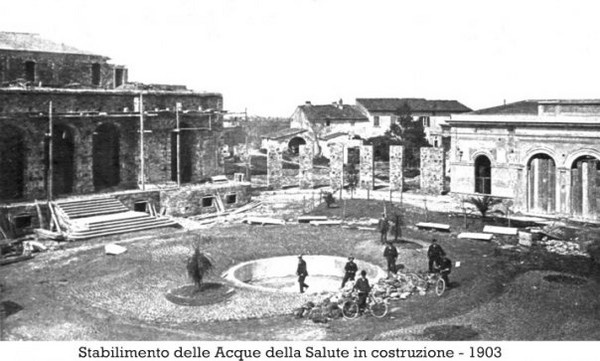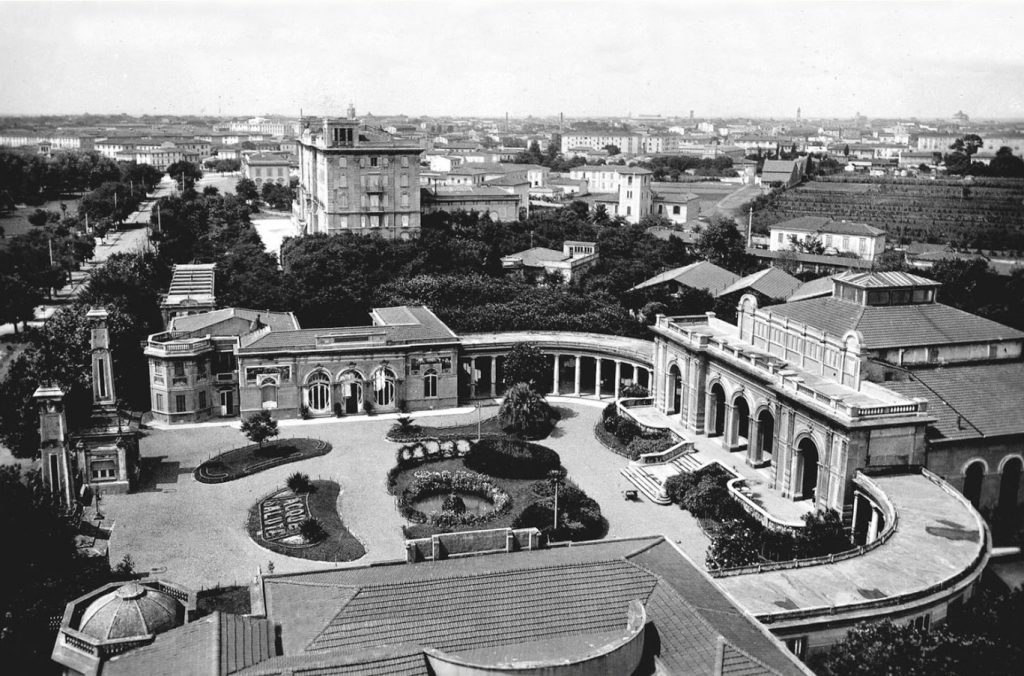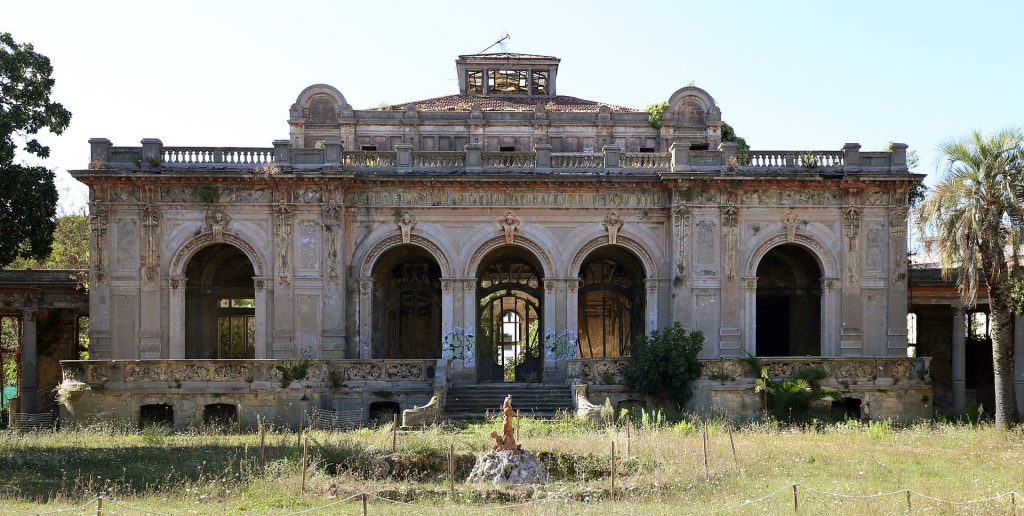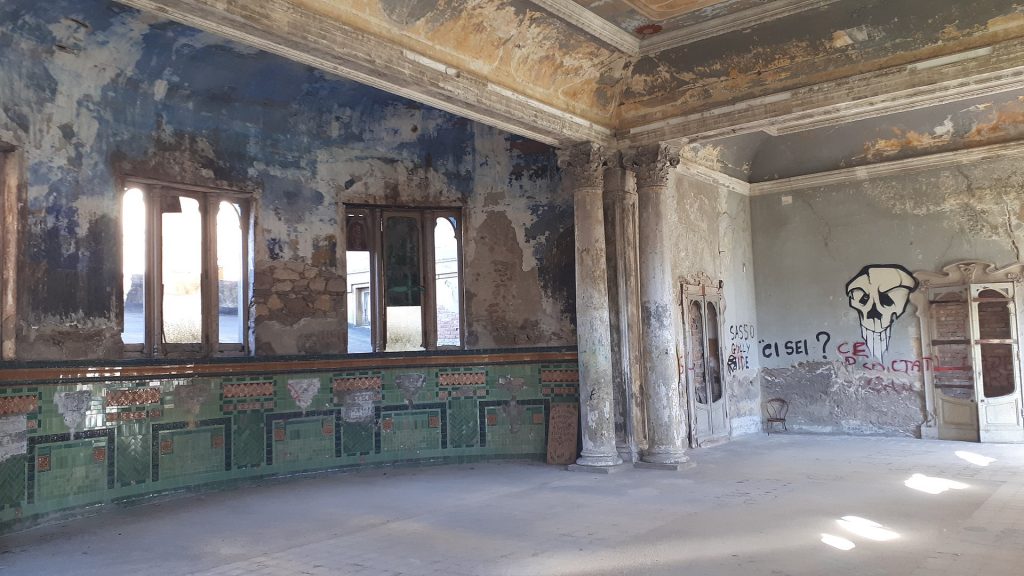Nel 1845 per la continua esigenza a reperire nuove fonti di approvvigionamento idrico per la Città, nell’area circostante la zona detta del Vigna furono individuate una decina di polle d’acqua di alta qualità. Dopo ricerche e analisi, già nel ’65 era attiva una edicola per la distribuzione delle acque.
Lo stabilimento Acque della Salute fu costruito, a partire dal 1903, su progetto dell’ingegnere Angiolo Badaloni, autore anche del grande Mercato delle vettovaglie di Livorno. L’area prescelta era quella posta al termine del rettilineo del viale degli Acquedotti (successivamente noto come viale Carducci), in una fascia ancora non urbanizzata a est della città.
Qui, presso l’antico podere del Pigna, nel 1854, era stata scoperta una polla d’acqua salata che, successivamente analizzata dai professori Giuseppe Orosi e Raffaele Garinei, fu ritenuta idonea alla cura delle malattie dell’apparato digerente. Nel 1856 alcuni cittadini si adoperarono affinché la sorgente fosse chiusa all’interno di un tempietto ottagonale per favorirne lo sfruttamento commerciale. Il successo fu tanto che nei primi anni del Novecento la polla fu rilevata dalla società Acque della Salute, che decise di costruirvi intorno uno stabilimento vero e proprio.
Le terme furono completate rapidamente e inaugurate nel luglio del 1904; nello stesso anno fu aperta una linea tranviaria che dallo stabilimento conduceva fino al centro cittadino. In breve le Acque della Salute divennero uno dei principali centri di attrazione di Livorno, che all’epoca era ancora una delle capitali italiane del turismo balneare. Per quelle che raggiunsero persino l’appellativo di “Montecatini a mare”, fu innalzato anche un lussuoso albergo, l’Hotel Corallo, dotato già all’epoca di ascensori elettrici.
In 1845, due to the continuing need to find new sources of water supply for the city, a dozen high quality water springs were identified in the area surrounding the area called the vineyard. After research and analysis, a newsstand for the distribution of water was already active in 1965.
The Acque della Salute plant was built, starting from 1903, on a project by the engineer Angiolo Badaloni, who was also the author of the large Livorno food market. The chosen area was the one located at the end of the straight line of the viale degli Acquedotti (later known as viale Carducci), in a still not urbanized strip to the east of the city.
Here, at the ancient Pigna farm, in 1854, a salt water pool was discovered which, subsequently analyzed by professors Giuseppe Orosi and Raffaele Garinei, was deemed suitable for treating diseases of the digestive system. In 1856 some citizens worked to ensure that the spring was closed inside an octagonal temple to favor its commercial exploitation. The success was so great that in the early twentieth century the pool was taken over by the Acque della Salute company, which decided to build a real plant around it.
The baths were quickly completed and inaugurated in July 1904; in the same year a tramway line was opened that led from the factory to the city center. In short, the Acque della Salute became one of the main attractions of Livorno, which at the time was still one of the Italian capitals of seaside tourism. For those that even reached the nickname of “Montecatini a mare”, a luxurious hotel was also built, the Hotel Corallo, already equipped at the time with electric lifts.
L’attività delle Acque della Salute proseguì fino alla seconda guerra mondiale; nel dopoguerra i padiglioni dello stabilimento furono trasformati in un locale da ballo, mentre fu potenziata l’attività di imbottigliamento.
Nel 1968 un incendio danneggiò porzione della copertura del padiglione centrale; l’intero complesso, a causa del disinteresse della proprietà, andò così incontro ad un progressivo decadimento. L’apertura, nel 1982, di un cavalcavia sulla vicina linea ferroviaria, proprio davanti alla grande esedra dello stabilimento, arrecò un notevole danno all’immagine della struttura.
Nella seconda metà degli anni novanta furono comunque avanzate alcune ipotesi di recupero, basate su un accordo tra Azienda Servizi Ambientali (ASA) e Coca-Cola, proprietaria dell’area dopo aver rilevato la STIB (Società Tirrenica Imbottigliamento Bevande), a cui appartenevano le terme sin dagli anni sessanta. L’operazione si concretizzò nel versamento di una caparra di 385 milioni di Lire e la costituzione di una società, controllata da ASA, avente lo scopo di avviare il progetto di recupero (la Nuova Corallo Srl); tale progetto prevedeva comunque la costruzione di alcuni nuovi edifici nell’area prossima allo stabilimento. Tuttavia, il piano non si concretizzò, complice anche il riassetto societario e la privatizzazione di ASA SpA.
Dopo anni di abbandono che ne hanno messo a rischio la stabilità. le Terme sono tornate a vivere grazie all’opera dei volontari in prospettiva di futuri restauri.
The activity of the Acque della Salute continued until the Second World War; after the war, the factory pavilions were transformed into a dance club, while the bottling activity was strengthened.
In 1968 a fire damaged a portion of the roof of the central pavilion; the whole complex, due to the lack of interest of the property, thus underwent a progressive decay. The opening, in 1982, of an overpass on the nearby railway line, right in front of the large exedra of the plant, caused considerable damage to the image of the structure.
In the second half of the nineties, however, some recovery hypotheses were advanced, based on an agreement between Azienda Servizi Ambientali (ASA) and Coca-Cola, owner of the area after having taken over the STIB (Società Tirrenica Imbottigliamento Bevande), to which the spa since the sixties. The operation took the form of the payment of a deposit of 385 million Lire and the establishment of a company, controlled by ASA, with the aim of starting the recovery project (Nuova Corallo Srl); however, this project envisaged the construction of some new buildings in the area next to the plant. However, the plan did not materialize, also due to the corporate reorganization and privatization of ASA SpA.
After years of neglect that have jeopardized its stability. the Baths have come back to life thanks to the work of volunteers with a view to future restorations.




